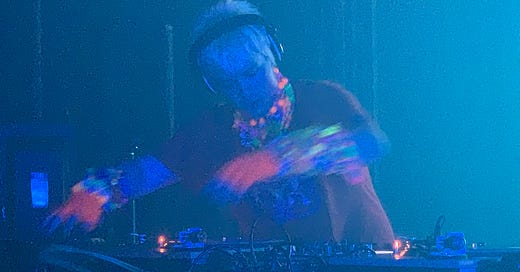NIGHTCLUB JITTERS: RAVING WITH FLAPJACK IN BROOKLYN
FOG, TURNTABLISM AND BLOODHOUND GANG REMIXES
The last time I played at Market Hotel in Bushwick was in the spring of 2017. Less than 10 people watched my set. Six years later, I found myself back at the venue, this time surrounded by a lot more people and a lot more fog and a lot more baggy pants. I was on a mission to see the number one DJ in America: Flapjack The Kandi Kid.
If you are not familiar with Flapjack, he dresses in full ‘90s candy raver gear and spins all-vinyl sets of happy hardcore, gabber and related forms of turbo-energy electronic music. Happy hardcore has historically been one of the least credible rave genres, but it is probably the most fun. When I think about the style, my mind goes to its majestic clichés: the pianos; the chipmunk diva vocals; the really fast BPMs. The music had its heyday over 20 years ago, when the Los Angeles DJ was a child.
Flapjack transcends what some might consider a gimmick with his skills on the decks. The motherfucker is sick with it. He is a turntablist in the true sense of the word, treating hard dance records like he is at a DMC competition in 1996. Flapjack owns hundreds of pairs of phat pants and thousands of happy hardcore records. His bedroom looks like a shrine to the culture. He might just be the Brian Setzer of American rave music.
I got in after midnight. The crowd was a mix of rave revivalists, hyperpop kids, Serious Brooklyn Techno People and regular ass New Yorkers who possibly found out about happy hardcore through Dance Dance Revolution. I think I spotted a member of NYC buzzband Frost Children, whose new record I’ve listened to and enjoyed, but I can’t be counted on to make an ID like that. Tama Gucci was warming the room, playing flips of “Come Clean” by Hilary Duff and “Pound Town” by Sexyy Red. Good shit, but not happy hardcore. The dancefloor was healthy enough. Then Flapjack stepped to the decks.
Market Hotel went from zero to rave in under a minute. The whistles came out and the crowd bunched up front. Flapjack’s candy necklaces glowed in the soft blue stage light. The JMZ roared through the windows. I could smell the faint whiff of burning plastic. Things were feeling… Legit.
Within his lane, Flapjack is a master of pacing. He knows how to blend the harder tracks with the anthemic tracks and the novelty tracks; he knows when to mix out of a record and when to scratch. Some songs he played that night almost sounded like European folk music. I spent the entire set Shazaming, but couldn’t catch a single cut. Not really a surprise. Flapjack did play what I think I can now identify as the DJ Hixxy remix of “The Bad Touch” by The Bloodhound Gang. Could there be more than one hardcore remix of that song? Absolutely.
Another highlight was a scratch routine over a rave flip of “Genie In A Bottle” by Christina Aguilera. Flapjack trades in the kind of turntablist hijinks you don’t see as much anymore, especially in the age of digital technology; even most dance music DJs that play vinyl aren’t doing it his way. I don’t think DJ Harvey is going to be scratching with his feet any time soon. Towards the end of the set, Flapjack held a turntable in the air and scratched some more. It was heroic.
If you were to ask a mod or garage rock revivalist in the ‘90s whether they thought rave culture had any staying power, they would’ve laughed in your face. But for years now, Flapjack has been committed to preserving happy hardcore in a way that mirrors a Northern Soul fanatic or even Steve Buccimi’s 78 freak in Ghost World.
When it came to the records he played, it was hard to know what was old and what was new. They all sounded fantastic. There are plenty of active labels making happy hardcore. I think about the genre in the same way I think about Oi! or goth or backpack rap or any subculture, really. Nothing ever dies.
It’s not like versions of rave music haven't been in and out of style for the past two decades, but I would assume that contemporary interest in Y2K-related aesthetics has led to greater happy hardcore visibility. In one interview, Flapjack complained about the increasing price of phat pants on the secondary market. I spotted him at the recent 100 Gecs Boiler Room. Things have changed since he entered the game in the late-2000s.
After Flapjack’s set, the LA DJ and producer Baseck took the stage to play an unrelenting set of rave music with live hardware. I remember him from the turn-of-the-century Midwest breakcore days. He was the turntablist wunderkind who would get flown to Wisconsin to perform at a series of barn parties called White Trash Wrestling. Those events were a reaction to the kind of candy-coated aesthetics Flapjack so aggressively pushes. Beer was the drug of choice and GG Allin provided more inspiration than any DJ.
But that was almost 25 years ago. Now it was nearing three in the morning and Baseck (a frequent Flapjack collaborator) was playing a remix of the Tetris theme song. Nobody seemed to be too concerned with anything but partying really hard. I was surprised that I had successfully attended a rave, but it was time to go. I descended the stairs; I was back on Myrtle Broadway, just steps away from the Popeyes and the Checkers and the Dunkin’ Donuts.



